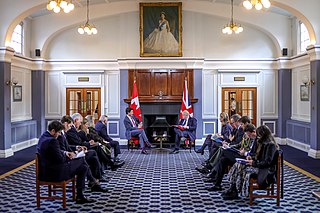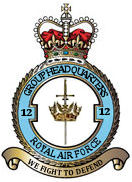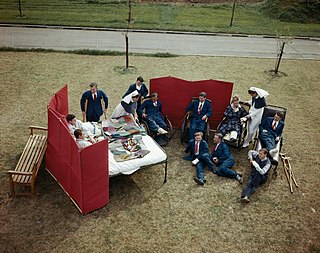
Uxbridge is a suburban town in west London and the administrative headquarters of the London Borough of Hillingdon. Situated 15.4 miles (24.8 km) west-northwest of Charing Cross, it is one of the major metropolitan centres identified in the London Plan. Uxbridge formed part of the parish of Hillingdon in the county of Middlesex, and was a significant local commercial centre from an early time. As part of the suburban growth of London in the 20th century it expanded and increased in population, becoming a municipal borough in 1955, and has formed part of Greater London since 1965.

Group Captain Sir Douglas Robert Steuart Bader, was a Royal Air Force flying ace during the Second World War. He was credited with 22 aerial victories, four shared victories, six probables, one shared probable and 11 enemy aircraft damaged.

Group captain is a senior commissioned rank in the Royal Air Force, where it originated, as well as the air forces of many countries that have historical British influence. It is sometimes used as the English translation of an equivalent rank in countries which have a non-British air force-specific rank structure. Group captain has a NATO rank code of OF-5, meaning that it ranks above wing commander and immediately below air commodore, and is the equivalent of the rank of captain in the navy and of the rank of colonel in other services.

RAF Northolt is a Royal Air Force station in South Ruislip, 2 nautical miles from Uxbridge in the London Borough of Hillingdon, western Greater London, England, approximately 6 mi (10 km) north of Heathrow Airport. The station handles many private civil flights in addition to Air Force flights. Northolt has one runway in operation, spanning 1,687 m × 46 m, with a grooved asphalt surface. This airport is used for government and VIP transport to and from London.

RAF Uxbridge was a Royal Air Force (RAF) station in Uxbridge, within the London Borough of Hillingdon, occupying a 44.6-hectare (110-acre) site that originally belonged to the Hillingdon House estate. The British Government purchased the estate in 1915, three years before the founding of the RAF. Until the outbreak of the Second World War in 1939, the station was open to the public.

RAF West Drayton was a non-flying Royal Air Force station in West Drayton, within the London Borough of Hillingdon, which served as the main centre for military air traffic control in the United Kingdom. It was co-located with the civilian London Air Traffic Control Centre to provide a vital link between civil and military flying and airspace requirements. Following the departure of the remaining civil and military air traffic control systems by 2008, the site was closed and demolished for a new residential development.

Reach for the Sky is a 1956 British biographical film about aviator Douglas Bader, based on the 1954 biography of the same name by Paul Brickhill. The film stars Kenneth More and was directed by Lewis Gilbert. It won the BAFTA Award for Best British Film of 1956. The film's composer John Addison was Bader's brother-in-law.

No. 12 Group of the Royal Air Force was a group, a military formation, that existed over two separate periods, namely the end of the First World War when it had a training function and from just prior to the Second World War until the early 1960s when it was tasked with an air defence role.

Princess Mary's Royal Air Force Nursing Service (PMRAFNS) is the nursing branch of the British Royal Air Force.

Project MoDEL is a project run for the Ministry of Defence (MoD) by the ministry's Defence Infrastructure Organisation and VSM Estates, a joint venture established between Vinci PLC and St. Modwen Properties to bid for the contract. The project involves the consolidation and sale of surplus Ministry of Defence properties around Greater London into around £180m of new developments at RAF Northolt. A total of 80% of the existing buildings at RAF Northolt were demolished and replaced by the newly built facilities.
The Royal Air Force cricket team is a cricket side representing the British Royal Air Force. The team played 11 first-class matches: nine between 1922 and 1932, mostly against other branches of the Services, and another two in 1945 and 1946. Their home ground is the Royal Air Force Sports Ground, Uxbridge.
Air Vice Marshal Frederick Crosby Halahan, was a gunnery officer in the Royal Navy during the early years of the 20th century who became involved in early naval aviation efforts.

RAF South Ruislip, also known as South Ruislip Air Station, was a non-flying Air Force station located in South Ruislip near London, England. Located close to RAF Northolt, the station was used by the United States Air Force's Third Air Force from 1949 until 1972, when the headquarters were moved to RAF Mildenhall.

RAF West Ruislip was a Ministry of Defence site, located in Ickenham within the London Borough of Hillingdon. The base was originally built as a depot for the Royal Air Force (RAF), split by what is now the Chiltern Main Line. North of the railway was RAF Blenheim Crescent, which housed the RAF Records Office and the depot's original personnel accommodation.

The Battle of Britain Bunker is an underground operations room at RAF Uxbridge, formerly used by No. 11 Group Fighter Command during the Second World War. Fighter aircraft operations were controlled from there throughout the War but most notably during the Battle of Britain and on D-Day. Today it is run by Hillingdon Council as a heritage attraction with attached museum. A new visitor centre above ground opened in March 2018.

Hillingdon House is a Grade II listed mansion in Hillingdon, Greater London. The original house was built in 1717 as a hunting lodge for the Duke of Schomberg. It was destroyed by fire and the present house was built in its place in 1844.

Air Commandant Dame Veronica Margaret Ashworth, was a British nurse, midwife, and Royal Air Force officer. From 1963 to 1966, she served as Matron-in-Chief of Princess Mary's Royal Air Force Nursing Service.

RAF Hospital Cosford was a Royal Air Force staffed military hospital at RAF Cosford, Shropshire, England. The hospital opened in 1940, and was one of a handful of Second World War era RAF hospitals that were kept open post Second World War, remaining a military asset until 1977, although it also treated non-service patients. It was known for its personnel reception centre, which dealt with returning prisoners of war in 1945.

The Princess Mary's Royal Air Force Hospital Halton, was the first Royal Air Force hospital to be built that was dedicated to air force personnel. Located on what was then the largest of the RAF camps at RAF Halton in Buckinghamshire, England, the hospital treated over 20,000 patients during the Second World War and was the first place in the world to use penicillin on a large-scale. The hospital continued in use throughout the Cold War, only closing in 1996 due to defence cuts.



















